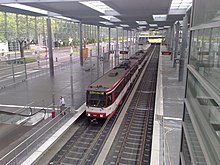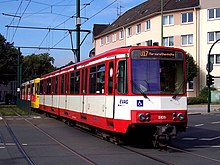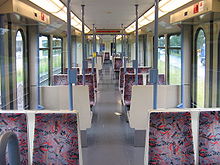Type B light rail car
| Light rail car B | |
|---|---|
|
B100S light rail car from Cologne and Bonn
|
|
| Manufacturer: |
DUEWAG , Siemens , Kiepe WU (10 vehicles) |
| Year of construction (s): | 1973-1999 |
| Axis formula : | B'2'B ' |
| Gauge : | 1435 mm ( standard gauge ) |
| Length over coupling: | 28,000 mm
38,000 mm (B80C / 8) |
| Width: | 2,650 mm |
| Empty mass: | 39.0 t |
| Top speed: | 100 km / h 80 km / h |
| Hourly output : | 2 × 235 kW = 470 kW |
| Seats: | 72 |
| Standing room: | 111 |
| Floor height: | 1000 mm |
| Low floor: | 0% |
The light rail vehicles B (short B-car ) is a normalspuriges high floor - rail -car, nearly 470 copies were from the 1973-1999 total prepared on different rail networks in North Rhine-Westphalia used.
The articulated vehicle was developed by the Düsseldorf wagon factory DUEWAG , which also built most of it. In general, these are 2.65 meters wide and 28 meters long two-part vehicles on three bogies with a total of six axles. Some vehicles in Dortmund have been lengthened with additional middle parts; these vehicles have four bogies with a total of eight axles and are 38 meters long.
development
At the end of the 1960s, plans were made to build a Rhine-Ruhr light rail network between Düsseldorf and Dortmund . The Stadtbahnwagen A , which was planned as a close-coupled double multiple unit, was intended as a uniform vehicle . The supply of traction current should take place via a side busbar. But a version for overhead line use and with folding steps for forward traffic was also discussed.
With the Stadtbahn Köln or Stadtbahn Bonn a separate tram network was to be created. There were two peculiarities: The light rail was supposed to use the Cologne-Bonn Railways (KBE) route network between Cologne and Bonn, which is why the vehicles had to be approved as railway vehicles according to the Railway Construction and Operating Regulations (EBO). In the inner city of Cologne a tunnel with tight curve radii had already been built for the tram , which the light rail should also use. At that time, the federal and state governments refused to take part in the financing because the required route elements for the Rhein-Ruhr Stadtbahn were not complied with for the operation of the A-car.



Since the rail cars A failed due to the latter condition, a private vehicle has been planned, the rail cars B was called. Three prototypes (two in Cologne, one in Bonn) were delivered in 1973. For the Rhein-Ruhr light rail network, light rail car B was finally taken over as a temporary solution and first used in Essen from 1977. Type A was never built for the light rail vehicles on the Rhine and Ruhr. A version with parameters based on the planned A-car was realized from 1981 for the Stuttgart Stadtbahn under the name DT 8 .
The Cologne and Essen cars had received the red / white "NRW paintwork". The Bonn cars had been painted in two shades of green.
The B-car was built in several series. The first version with a split windscreen (B100S) runs in Cologne (2000 series), Bonn (74xx to 77xx) and Essen / Mülheim an der Ruhr (50xx series). For the opening of the Düsseldorf Stadtbahn in 1981, the Rheinbahn procured 12 type B 80 (4001-4012) carriages in steel construction. These vehicles already had a one-piece windscreen and large target film boxes as well as a three-phase drive. The top speed was only 80 km / h. A new version with an aluminum structure and modified folding steps (for easier boarding) was used in Düsseldorf from 1984 (series 41xx to 42xx), some with a buffet room (Rheinbahn-Bistro; 4101-4104). In these vehicles, the single door in the driver's seat on the left was also left out in favor of a larger driver's area. The doors of the vehicles in the pre-production series were subsequently removed. For Duisburg a similar type of car was delivered, but in steel construction (47xx). Some were equipped with a dining area. Duisburg and Düsseldorf (there already on the articulated trams of the type GT8S ) also chose the light rail paint, but in a darker red.
From 1983 Bonn (83xx and 84xx) and Cologne (2100) procured further B-series, which looked more like the Duisburg type. A series used in Cologne, which originated in the late 1980s, only has one driver's cab at one end of the car (series 2200) and therefore only runs in double traction . The Berliner Waggon Union delivered ten vehicles of this type to Cologne. This delivery was further developed into a new series (2300) in 1993, which now again had two driver's cabs . Forms of the B-car based on this are also used in Bochum and Dortmund , there also as an eight-axle variant with a central section.
Versions similar to the Stadtbahnwagen B are available from the Stadtbahn in Karlsruhe (see also GT6-80C , GT8-80C , GT8-100C / 2S ). B-cars also drive in Mexico City (en) , Monterrey (en) , Guadalajara . Furthermore, railcars with B-parameters are coming abroad in Lausanne (B-compatibility due to the export hopes of the manufacturer), London (with power rail, some of them now run after conversion for overhead line operation in Essen), Newcastle upon Tyne , Pittsburgh (en) , St Louis , Ankara (with power rail) and Bursa / Turkey (there the original DUEWAG design). Some first series vehicles from Cologne were sold to Istanbul in 2007 .
successor
The B-car has not been further developed since 1994. Different manufacturers offer vehicles with similar parameters to replace old vehicles. For the first time in 2018, a new generation of the B-car for the Dortmund Stadtbahn was announced, which in terms of production technology will be classified under the Vamos series from the manufacturer HeiterBlick . The generation is now called B80D Vamos .
- Siemens CitySprinter
- Bombardier Flexity Swift (K5000)
- Stadler Tango
- Bright View Vamos Dortmund ; new generation of the B-car (B80D)
So far, Bombardier has sold 73 vehicles to Cologne and Bonn, which were delivered in 2002/2003. The B-wagons that were decommissioned in Bonn were won by the Dortmund municipal utilities in an international bidding competition in 2004.
Bochum ordered six Stadler Tango in 2005 . Contrary to the original specification, these vehicles cannot be combined with the existing B80D. However, it is planned to have their technical systems modernized by Stadler . This would not only increase the service life to approx. 40 years, but also create the possibility of using mixed double tractions.
In April 2018, Dortmund's public utility company ordered 24 new HeiterBlick B80D Vamos cars . The B-cars taken over from Bonn are to be decommissioned.
Modernizations
Due to cuts in vehicle funding and dissatisfaction with the successor series, both the Bonn and Cologne transport companies have decided to forego new acquisitions in the medium term and instead to comprehensively modernize their oldest B-cars. The Dortmunder Stadtwerke decided to modernize old B-cars in addition to purchasing new ones.
Second position Bonn
Stadtwerke Bonn began in 2009 with the so-called “second production” of their 25 B-cars built between 1974 and 1977, which are to be made ready for use for a further 25 years of operation. For around 1.3 million euros per vehicle, new, regenerative drives will be installed, the driver's cab will be enlarged, and the front of the vehicle and the passenger compartment will be redesigned. The prototype was originally supposed to be finished in late 2009, but wasn't finished until 2012. Since then, the second production of the vehicles has been carried out in Beuel in cooperation with the SWB depot in Dransdorf , where the painting work is carried out (as of August 2019).
Remodeling Cologne
The Kölner Verkehrs-Betriebe started the comprehensive modernization of 28 B-cars from the years 1984 and 1985 to the type K2400. For 1.6 million euros per vehicle, a driver's cab, the interior and the front design will be modernized and a temperature control system installed. The second driver's cab has been omitted in favor of an enlarged passenger compartment, which means that the vehicles, like the 2200 series, can only be used in double traction. A prototype was produced until June 2011, and since 2012 seven vehicles have been converted every year. In June 2014, the first two converted wagons of the new type K2400 were presented to the public and put into operation and by 2019 all 28 B-wagons of the 2100 series should be successively converted.
Retirement and renovation in Dortmund
In December 2013, the Dortmund municipal utilities decided to modernize the 64 B80 type B cars and to order up to 26 new cars. The 10 type B100 wagons taken over from Bonn are to be retired in return. The original plan was to carry out the modernization between 2016 and 2025. In April 2018, the entire contract was awarded to the companies HeiterBlick and Kiepe Electric . The companies will build 24 new Vamos light rail cars; the order can optionally be expanded to 26 cars. The first new wagons should arrive from 2020, and the modernization of the old wagons should begin at the same time. The new cars should be indistinguishable from the modernized cars. The modernization includes thermal insulation, optimized ventilation systems, air-conditioned driver's cabins and larger special-use areas accessible from all doors. The passenger information is to be improved by monitors, guide strips, colored LEDs and loudspeakers on the doors.
B-car in Germany
Legend:
80: top speed 80 km / h
100: top speed 100 km / h
C: DC motor with chopper control
D: three-phase motor
S: DC motor with switch gear control
/ 6: six-axis
/ 8: eight-
axis
| city | Type | Construction year | Vehicle number | Remarks |
|---|---|---|---|---|
| Bochum | B80D | 1988-1993 | 6001-6025 | without folding steps, outward swinging doors |
| Bonn (SWB) | B100S | 1973 | 7351 | Prototype, split windscreen, sliding doors, from 2003 spare parts dispenser in Dortmund, scrapped in summer 2006 |
| B100S | 1974-1977 | 7451-7467 7651-7654 7751-7760 |
split windscreen, pivoting sliding doors, 13 pieces sold to Dortmund in 2003 | |
| B100S | 1984 | 8451-8456 | Pivoting sliding doors | |
| B100C | 1993 | 9351-9364 | Pivoting sliding doors | |
| Bonn (SSB) | B100S | 1975 | 7571-7578 | split front window, pivoting sliding doors |
| B100S | 1983/1984 | 8371-8378 8471 |
Pivoting sliding doors | |
| B100C | 1993 | 9371-9376 | Pivoting sliding doors | |
| Dortmund | B80C / 6 | 1986-1993 | 301-343 | Outward swinging doors, 343 from 1998 to 2000 with a plastic middle section on a trial basis |
| B80C / 8 | 1993/1994 | 344-354 | Outward swing doors, delivered as a six-axis model, later converted to the B80C / 8 | |
| B80C / 8 | 1998/1999 | 355-364 | Outward swinging doors, delivered as eight-axle vehicles | |
| B80S | 1974 | 401-411 | (from Bonn) split windscreen, 401–410 in operation; 411 has since been scrapped, converted from B100S | |
| Dusseldorf | B80D | 1981 | 4001-4012 | Folding doors , 4001 no longer in use since the accident in 2001 |
| B80D | 1986 | 4101-4104 | Folding doors, dining area | |
| B80D | 1986-1990 | 4201-4288 | Folding doors | |
| Duisburg | B80C | 1983 | 4701-4714 | Folding doors |
| B80C | 1984 | 4715-4718 | Folding doors, conversion from dining car, only three double doors per side | |
| eat | B80C | 1976 | 5101-5111 | Pivoting sliding doors, split front window, conversion from B100S |
| B80C | 1978 | 5121-5128 | Folding doors, split windshield, conversion from B100S | |
| B80C | 1985 | 5141-5145 | Folding doors | |
| Cologne | B100S | 1973 | 2001 + 2002 | Prototypes, split windshield, sliding and sliding doors, scrapped |
| B100S | 1976 | 2003-2029 | Split windscreen, pivoting sliding doors, in 2012 as a museum car in the Cologne-Thielenbruch Tram Museum , the remainder scrapped or sold by 2009 | |
| B80S | 1977 | 2030-2049 | Split windscreen, pivoting sliding doors, with the exception of cars 2031, 2032, 2035 and 2049, scrapped or sold since 2009 | |
| B100S | 1978 | 2050-2054 | Split windscreen, sliding and sliding doors, scrapped or sold by 2009 | |
| B100S | 1977 | 2095-2099 | Split windscreen, pivoting sliding doors, until 1992 KBE 2095–2099, scrapped or sold until 2009 | |
| B100S | 1984/1985 | 2101-2122 | Swivel sliding doors, 2118 retired | |
| B100S | 1986 | 2192-2199 | Pivoting sliding doors, until 1992 KBE 2192–2199, 2197 no longer available | |
| B80D | 1987-1992 | 2201-2240 | 1 driver's cab, outward swinging doors | |
| B80D | 1988/1989 | 2251-2260 | 1 driver's cab, outward swinging doors, manufacturer: Waggon Union | |
| B80D | 1993/1994 | 2301-2333 | Outward swing doors | |
| Mülheim an der Ruhr | B80S | 1976 | 5012-5016 | Pivoting sliding doors, split front window |
| B100S | 1985 | 5031-5032 | Pivoting sliding doors |
See also
Web links
Individual evidence
- ↑ a b Equipped for the future - the next few years will bring new and modernized light rail vehicles and e-buses. DSW21 , April 27, 2018, accessed February 14, 2019 .
- ↑ SWB Managing Director Heinz-Jürgen Reining: "What you get on the market today does not have the quality we want". Quoted in: Christoph Meurer: Only the bodies remain ; General-Anzeiger dated December 30, 2008
- ↑ Stadtwerke Bonn: Our “Turn old-make-new” concept: The major SWB project “Second position” ; Brochure from March 23, 2012; P. 6 (pdf; 3.1 MB). Stadtwerke Bonn: The major SWB project "Second position": Since December 2012: our new railway in regular service ; ( Memento of June 6, 2013 in the Internet Archive ) Retrieved May 25, 2013.
- ↑ a b c Make new out of old: With the renewal of light rail vehicles, Stadtwerke Bonn is part of Bonn's sustainability strategy. SWB, August 14, 2019, accessed November 17, 2019 .
- ^ Bonn: 25 light rail vehicles are being modernized. Eisenbahnjournal Zughalt.de, July 9, 2010, accessed on April 6, 2011 .
- ↑ KVB modernizes complete series of light rail vehicles ; ( Memento from March 19, 2009 in the Internet Archive ) Press release of the Cologne transport company from November 25, 2008
- ^ Stephan Anemüller: Stadtbahn Umbau: Proven vehicles in a new quality. blog.kvb-koeln.de, June 14, 2016, accessed on April 6, 2011 .
- ↑ KVB renovate their B-wagons. Eisenbahnjournal Zughalt.de, April 6, 2011, accessed on April 6, 2011 .
- ↑ Matthais Pesch: Stadtbahnen introduced - new KVB trains - from the 80s. Kölner Stadt-Anzeiger, June 13, 2014; accessed on November 17, 2019.
- ↑ The vehicle fleet of the Cologne transport company. stadt-koeln.de, accessed on November 17, 2019 .
- ↑ The timetable for new vehicles is available. DSW21 , December 10, 2013, accessed February 14, 2019 .
- ↑ Vamos Dortmund - attractive and modern vehicles. HeiterBlick , accessed February 14, 2019 .






